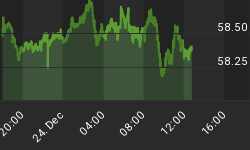Rotational combines component rotation and asset class rotation to hold a small basket of ETFs or ETNs, selecting the handful with the most momentum from a representative sampling of classes and components. Throughout this article, when I refer to momentum, I am referring to an exponentially smoothed measure based solely on price movement.
Information is as of the close on February 8, 2008.
Model Allocation
Based on beginning with a $100,000 portfolio at inception, these are the current weights and holdings. The initial target was a buy of 10% weights per position. See my previous post on this system. Sort is alpha order by ticker and weights are rounded to the tenth of a percent.
Agriculturals (DBA) - 11.2%
Brazil (EWZ) - 9.3%
Euro Currency (FXE) - 10.1%
Gold (GLD) - 11.6%
India (INP) - 9.4%
Energy, Clean (PBW) - 9%
Russia (RSX) - 8.7%
Materials, Steel (SLX) - 10.1%
Treasuries 20+ Yrs (TLT) - 10.4%
Oil (USO) - 10.1%
Cash (Cash) - 0.1%
Returns
Based on beginning with a $100,000 portfolio at inception.
Equity: $96,321.80
Gain, Past 4 Weeks: -6.55%
Gain, Year to Date: -5.21%
Gain, Since Inception: -3.68%
The following ETFs in the Rotational portfolio paid dividends or distributions in the past four weeks: FXE and TLT. Payments for both are included in the "Past 4 Weeks" return and in the "Year to Date" return.
Total dividends = $63.87 on the tracking portfolio. This amount is included in the returns shown above, and will remain in cash until needed for a new purchase. Note, commissions are expensed at $10.00 per trade when accounting for returns.
Changes To Model Allocation
Rotational screens for momentum inside a list of ETFs and ETNs by asset class category. Provided that momentum is positive, one issue from each asset class will be held, with the remainder of positions allocated to the issues with the most momentum, regardless of asset class.
If this system were to be initiated today, the target allocation would be a buy for 10% weight holdings of the ten issues highlighted in gold or green in the table below. Items highlighted in gray are "sells" from the existing model portfolio. Note that five of the six asset classes have at least one bullish member, and the other five allocations this period go to other ETFs that are leaders in my smoothed momentum measurement.

Tracking
Shares of FXE, SLX, PBW, and RSX will be sold, market at open on Monday. The proceeds, plus all available cash, comprise 38.0% of portfolio weight, and will be split equally into allocations for new buys SLV, GDX, FXY, and EWM, based on closing prices on February 8. I will round down any fractions in the share calculation.
















